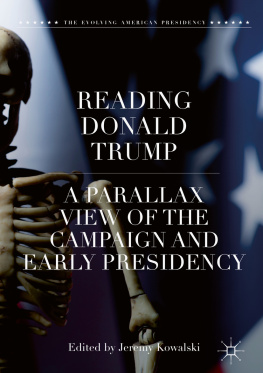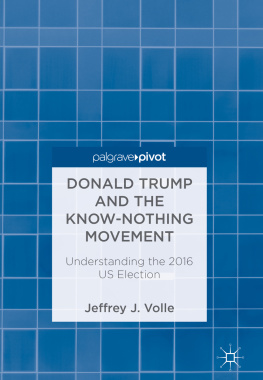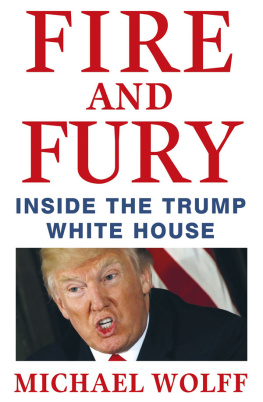Contents
Guide

Simon & Schuster
1230 Avenue of the Americas
New York, NY 10020
www.SimonandSchuster.com
Copyright 2019 by Julie Hirschfeld Davis and Michael D. Shear
All rights reserved, including the right to reproduce this book or portions thereof in any form whatsoever. For information, address Simon & Schuster Subsidiary Rights Department, 1230 Avenue of the Americas, New York, NY 10020.
First Simon & Schuster hardcover edition October 2019
SIMON & SCHUSTER and colophon are registered trademarks of Simon & Schuster, Inc.
For information about special discounts for bulk purchases, please contact Simon & Schuster Special Sales at 1-866-506-1949 or
The Simon & Schuster Speakers Bureau can bring authors to your live event. For more information, or to book an event, contact the Simon & Schuster Speakers Bureau at 1-866-248-3049 or visit our website at www.simonspeakers.com.
Interior design by Joy OMeara
Jacket design by Richard Ljoenes
Jacket photograph by John Moore / Getty Images
Library of Congress Cataloging-in-Publication Data is available.
ISBN 978-1-9821-1739-9
ISBN 978-1-9821-1741-2 (ebook)
For our families:
Jonathan, Claire, Harry, and Rose
Caitlin, Sam, and Sophie
The question is about your legacy. Will you be remembered as Donald Trump, the xenophobic president?
I hope not. Because Im not that way. I hope notI think youre rightI think the perception might be more that way than the other. I hope not. I would like to have a great immigration policy, Id like it to be fair. I do not want criminals coming into our country. I dont think you do either.
Donald J. Trump
The Oval Office
June 25, 2019
PROLOGUE
PRESIDENT TRUMP WAS OBSESSING again.
It was the afternoon of December 4, 2018, just two days after his return to Washington, D.C., from a quick, three-day trip to Buenos Aires. The world was mourning the death of George H. W. Bush over the weekend, and the screens of the many televisions Trump had installed in the White House were filled with glowing tributes to the ninety-four-year-old icon. Trump was in the Oval Office, where he had just finished signing a bill to fund the Coast Guard. But as his guests were ushered out, Trump asked Kirstjen Nielsen, his secretary of homeland security, to stay behind. He wanted to talk about the wall.
That was no surprise to Nielsen. In almost every conversation she had with the president, no matter the topic, Trump eventually found his way to the wall. He raised it in the middle of meetings that had nothing to do with immigration or border security. He buttonholed her at social occasions, like after a movie screening in the White House family theater, to ask, Kirstjen, what about the wall? He called her at home, usually before 7 a.m., to complain or muse about it, often flinging f-bombs about how ugly the existing wall looked and demanding that she do something about it. Sometimes, his outburst was prompted by a fleeting image of a section of the wall during a segment on Fox News or a snarky tweet from a critic about his demands for a barrier on the southern border. Other times, it seemed to come out of nowhere. But in Trumps mind, those close to him could see, the building of the wall and its physical appearance were directly correlated to his own success as presidentthey were an extension of himself. And if there was one thing Trump loved to talk about, it was himself.
Its got to be steel bollards, Trump told Nielsen that afternoon, describing his vision for what seemed like the millionth time. This was his latest infatuation. During his campaign, Trump had said he wanted a wall built of precast cement slabs, and as president he had proudly posed for the cameras in front of massive, concrete prototypes that towered over him. But he had since shifted his focus. Border officials didnt like concrete walls because they made it impossible to know who or what was on the other side. Besides, his homeland security advisers had explained to him, concrete was exceedingly easy to break apart. All you had to do was drill a small hole and inject expanding groutavailable cheap from any Home Depotand within twenty-four hours, the cement would begin to collapse. After many months of painstaking conversations, Trump had been convinced that heavy-duty steel posts were the way to go instead, and that was what his Department of Homeland Security had signed contracts to have built.
Love that design. Gotta be steel bollards, Trump told Nielsen. But its got to be the bollards right next to each other. Just the bollards. He showed with his hands what he meantkind of like toothpicks standing straight up, right next to each other.
That might work, Nielsen said, as she explained, once again, that such a design would require some kind of stabilizing bar at the top. Otherwise, the engineers said it would be too easy for someone to pull down individual poles or spread them apart and slip through the barrier into the United States.
No. No. No, Trump said. If you have a bar at the top, people can throw a rope over it and climb over the fence. Plus, its ugly. This has to be beautiful. Think of it like flagpoles, he told Nielsen, using his hands again to demonstrate a series of lines placed close together. A flagpole next to a flagpole next to another flagpole. I have the best flagpole guy in the country, Trump assured her. Ill put you in touch with him. And also, he continued, the tops of the poles have to be sharp and pointy, so that no one will dare try to climb over it. And the pointy parts should be painted black, so that they get hot in the bright sun. That will help to deter anyone trying to climb up.
By now, everyone around Trump had become accustomed to the presidents extraordinarily detailed lectures about the wall. He saw it as the embodiment of his presidency, a hulking physical reflection of his giant political brand, and he was obsessed with every aspect of it, down to the kind of black paint that should be used. Flat black! he would insist, both because it would draw in the most heat and make the structure too hot to touch, and because it would be beautiful, he said. He was reluctant to let go of the idea even after Nielsen informed him that his preferred matte black paint would cost an additional $1 million per mile of wall. Nor was Trump discouraged by the practical challenges associated with building the structure, which involved a painstaking, often impossible process of poring over property recordssome so outdated they were still on microficheto identify who owned the land where it would be erected. Just take the land and let them sue us, Trump would say. In one meeting with a group of Republican senators at the White House, Trump had veered off topic and offered another reason the border wall had to be sharp and hot on top. It was so that birds would be less likely to land on it and take a shit, sullying his beautiful edifice.
But the presidents overarching goal was to make the experience of crossing the border into the United States as terrifying and perilous as possible. At one point, Trump became enamored of the idea of digging a trench along the border, so much so that Nielsen asked the Army Corps of Engineers to calculate the cost. (Twice to three times as expensive, they reported back.) Discussions with his advisers ensued about what would be inside the ditch: Water? Alligators? Snakes? Some of the presidents proposals were so outlandish that aides could not even tell whether he was serious. Trump was crystal clear on one point, though: the wall should be dangerous enough to dissuade immigrants from even attempting to scale it. More than once, he had instructed officials at the Department of Homeland Security to look into whether the wall could be electrified so that anyone touching it would receive a shock. He wanted the spikes on top to be sharp enough to pierce human flesh in an instant. He wanted concertina wire everywhere. Trump had vivid descriptions of what he wanted immigrants to experience if they tried to scale the wall: They would be burned, maimed, cut to pieces by the wire. I want these people to be in horrible shape if they climb up, the president would say.











